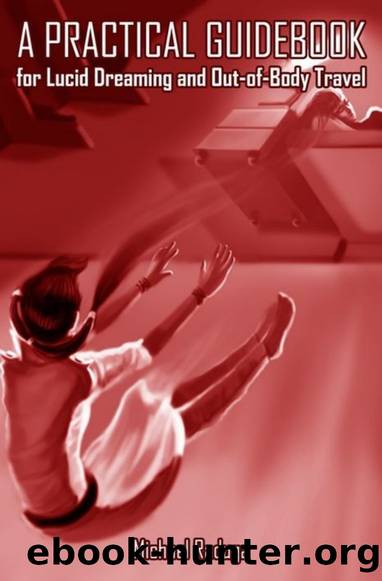A Practical Guidebook: For Lucid Dreaming and Out-of-Body Travel by Michael Raduga

Author:Michael Raduga [Raduga, Michael]
Language: eng
Format: epub
Barnesnoble:
Published: 0101-01-01T00:00:00+00:00
Chapter 8 - Primary skills
THE ESSENCE OF PRIMARY SKILLS
When dealing with a fully-realized phase, requisite knowledge is not limited to entry techniques, deepening and maintenance of the state, translocation, or finding and interacting with objects. In order to feel comfortable, a practitioner has to master or at least acclimate himself with a whole series of techniques to correctly react in any number of situations. For example, a practitioner needs to know how to create vision, if it is absent. Actions including passage through a wall or taking flight in a deep phase do not happen easily, although these actions may be assumed natural occurrences, since the phase exists apart from the physical world. In addition to techniques that allow interaction with the physical setting and surroundings of the phase, methods must learned and applied to counteract fear if it forces a practitioner to consciously and consistently leave the phase.
A practitioner does not have to know all the primary skills by heart, but it is necessary to pay close attention to some of them: emergency return, creation of vision, translocation through objects, contact with animate objects, and, for many, skills dedicated to fighting fear will also prove extremely relevant.
The final choice of methods that require added focus on the part of the practitioner must be made on the basis of personal experiences and problems faced while in the phase, since different practitioners often have completely different types of problems.
DISCERNING THE PHASE
Problems with phase identification during entry often arise at the initial stages of studying the phase. A practitioner simply cannot understand whether or not he or she is already in the 115
Buy hard copy of this e-book on www.obe4u.com
phase. This uncertainty can manifest while lying down or while practicing in other postures.
If a practitioner is simply lying down, physically perceiving his own body, and doing nothing, then it is indeed difficult to determine whether or not he is present in the phase. It is sufficient to note that there might be no signs of a phase state.
On the contrary, there may be a host of signs and unusual sensations, but they by no means necessarily indicate the onset of the phase.
The problem of the uncertainty of a phase state is always solved through actions. If the practitioner is lying down, then standard separation techniques may produce indication of phase achievement - in the majority of cases â since such techniques may often be incorrectly performed.
It is possible to perform techniques that are only achievable in the phase state. If a practitioner stands up and does not recognize his surroundings, then it can be assumed that the practitioner is standing up in the phase. However, often based on the observation that âeverything is as in realityâ, a practitioner may stand up and note that everything is in fact âas in realityâ
simply because the practitioner is still in ârealityâ. In answer to this dilemma, the phenomenon of hyper-concentration has been previously mentioned in relation to maintaining phase. By using hyper-concentration, it is always possible to ascertain whether the practitioner is in the phase.
Download
This site does not store any files on its server. We only index and link to content provided by other sites. Please contact the content providers to delete copyright contents if any and email us, we'll remove relevant links or contents immediately.
Animal Frequency by Melissa Alvarez(4394)
Sigil Witchery by Laura Tempest Zakroff(4179)
Real Magic by Dean Radin PhD(4073)
Fingerprints of the Gods by Graham Hancock(3939)
Aleister Crowley: The Biography by Tobias Churton(3586)
Journeys Out of the Body by Robert Monroe(3567)
The Rosicrucians by Christopher McIntosh(3465)
Alchemy and Alchemists by C. J. S. Thompson(3448)
Mysteries by Colin Wilson(3394)
Hitler's Monsters by Eric Kurlander(3268)
The Hatha Yoga Pradipika (Translated) by Svatmarama(3227)
John Dee and the Empire of Angels by Jason Louv(3130)
Wicca: a guide for the solitary practitioner by Scott Cunningham(3125)
Infinite Energy Technologies by Finley Eversole(2938)
Book of Life by Deborah Harkness(2865)
Dark Star Rising by Gary Lachman(2828)
The Book of Lies by Aleister Crowley(2800)
Aliens by Jim Al-Khalili(2786)
To Light a Sacred Flame by Silver RavenWolf(2767)
